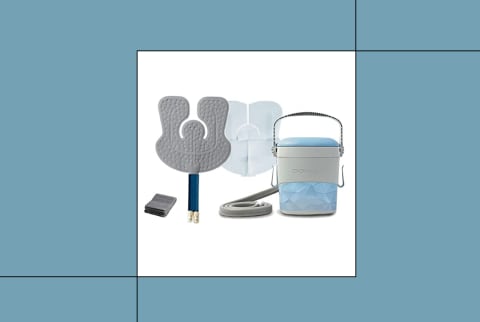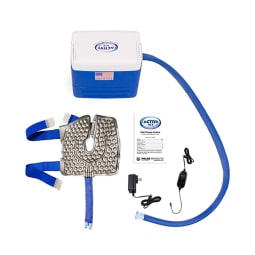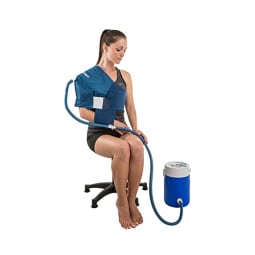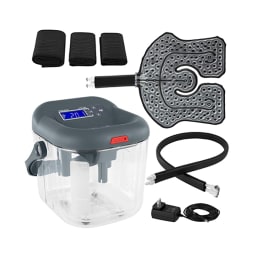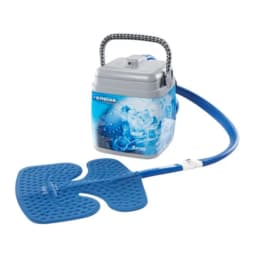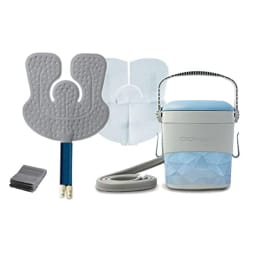On a recent episode of the mindbodygreen podcast, cold therapy expert Mark Harper, M.D., Ph.D. discussed the effects of cold water immersion. “I wrote a paper5 suggesting that by putting people through a cold water adaptation program before surgery, you could reduce the number of complications,” he explained. “One of the key aspects to why it might reduce complications is because cold water adaptation, as part of the response to stress, reduces your inflammatory response.”
There are many ways to reap the many benefits of cryotherapy (jumping into a chilly body of water, taking a cold shower, to name a few). However, if you’re hoping to target a specific area of the body, you may want to consider a cold therapy machine. These devices offer quick relief after a difficult workout, and can help promote faster recovery from an injury.
Below, learn more about how these machines work, along with our picks for the best cold therapy machines of 2022.
“Different machines may work in different ways, some utilizing water as a conductor of heat where others may rely on more drastic shifts in ambient temperature,” says Charles Tabone, N.D., in-house naturopathic doctor at Pause Studio in Los Angeles, CA. “Across the board, cold therapy machines are using the body’s physiological response to temperature change and piggybacking off the downstream effects.”
One effect of these machines is that the cold temperature application can cause vasoconstriction6 (your blood vessels get smaller and constrict blood flow). When the cold is removed, your blood vessels open up (vasodilation), which may help with muscle reoxygenation7 and recovery.
In case you don’t want to take daily trips to a doctor’s office or clinic, there are a number of cold therapy devices available for home use. The exact mechanics vary slightly across different brands and models, so the right choice depends on your specific wants and needs—which should always be discussed with your healthcare provider.
However, Tabone does offer caution around using these devices for longer than the recommended amount of time, explaining that, “If tissue gets too cold for too long, damage can occur.” It’s also important to be aware of any manufacturer safety warnings, particularly because these machines use both water and electricity.
As with any new practice, it’s a good idea to speak with your healthcare practitioner before implementing cold therapy into your routine. Specifically, Tabone says “Anyone of extreme (young or old) age, individuals with serious cardiovascular conditions, pregnant women, and people with major wound healing” should take extra caution.
Cost is another factor to consider. “It’s far more economical to stand in a cold shower or jump into a cool body of water,” Tabone agrees. “On a plus side, though, often it’s the investment in a recovery device or membership that helps cement a routine, the most important thing is finding a way to maintain a practice.”
Consider how you’ll be using the cold therapy machine: Does it need to be fully portable? If so, you may prefer a battery-powered option. Are you looking to treat a specific body part? Make sure the machine comes with compatible therapy pads.
Each cooling reservoir can be used with ice or frozen water bottles, which last longer. Once the reservoir is filled is filled, you can use the programmable digital timer to determine the desired water temperature and length of your treatment. Just remember you’ll need to stay within 5 feet of the compression machine. Luckily, there are optional 12-volt DC adapters and portable batteries available for treatment on the go.
When used with the shoulder cuff, it covers the entire shoulder, circulating over the effect area. It also offers controlled compression, which helps minimize swelling and pain. A number of reviews say the Aircast offered relief after rotator-cuff surgery, and helps keep inflammation at bay.
Just remember the Aircast DonJoy Cold Therapy system and the shoulder cuff are sold separately.
Similar to other designs, it opts for a universal cooling pad, which can be attached to ankles, knees, legs, hips, elbows, shoulders, or arms using the included elastic straps. However, the portability of this design is what really sets it apart; the handle can easily be tucked into the unit and the flexible pad can be folded for transport. Testers only have positive things to say about the device, giving it positive feedback for providing relief after surgery, an intense workout, and more.
While this unit offers a number of different therapy “blankets” or pads, many customers highlight how it was particularly helpful following knee replacement surgery, especially because of how easy it is to transport.
Customers also call out that the system works better when you add frozen water bottles to the cooler, rather than ice cubes.



